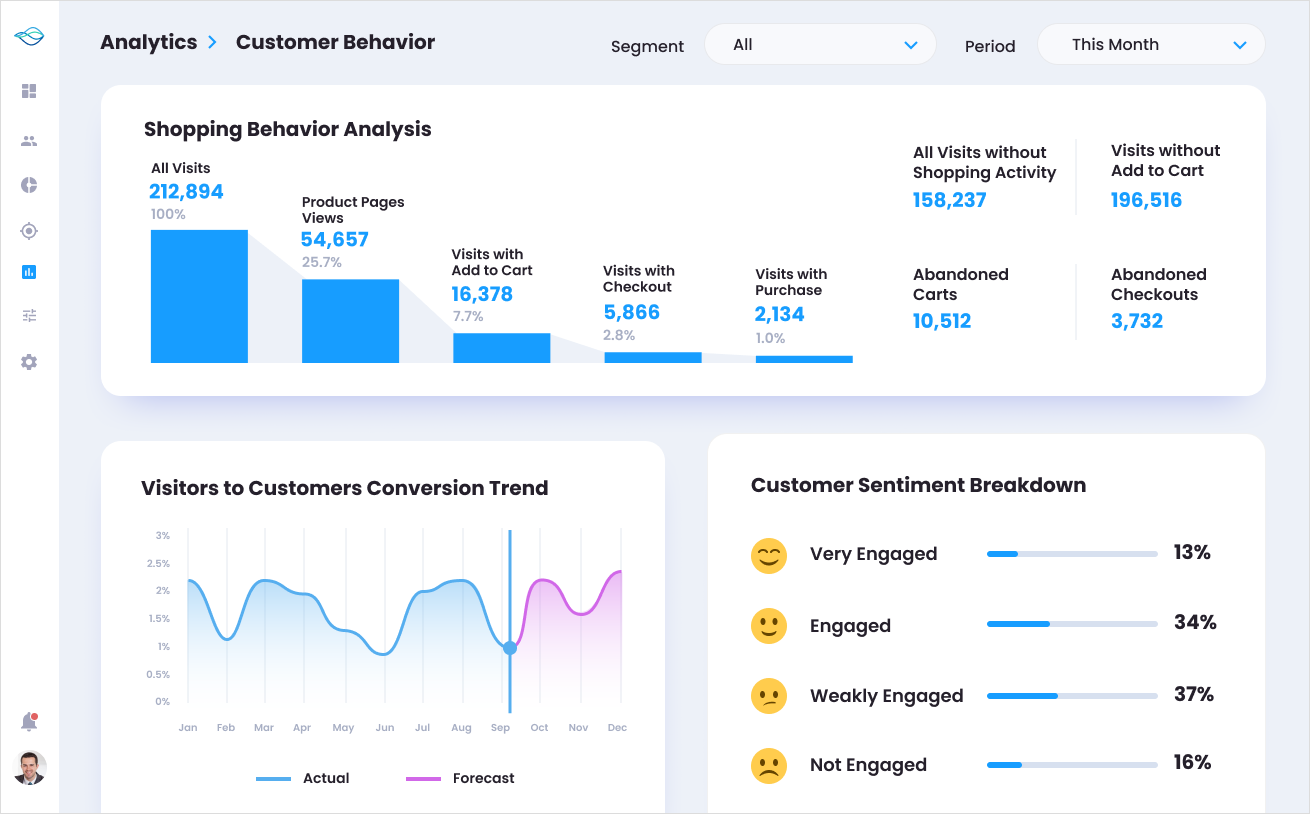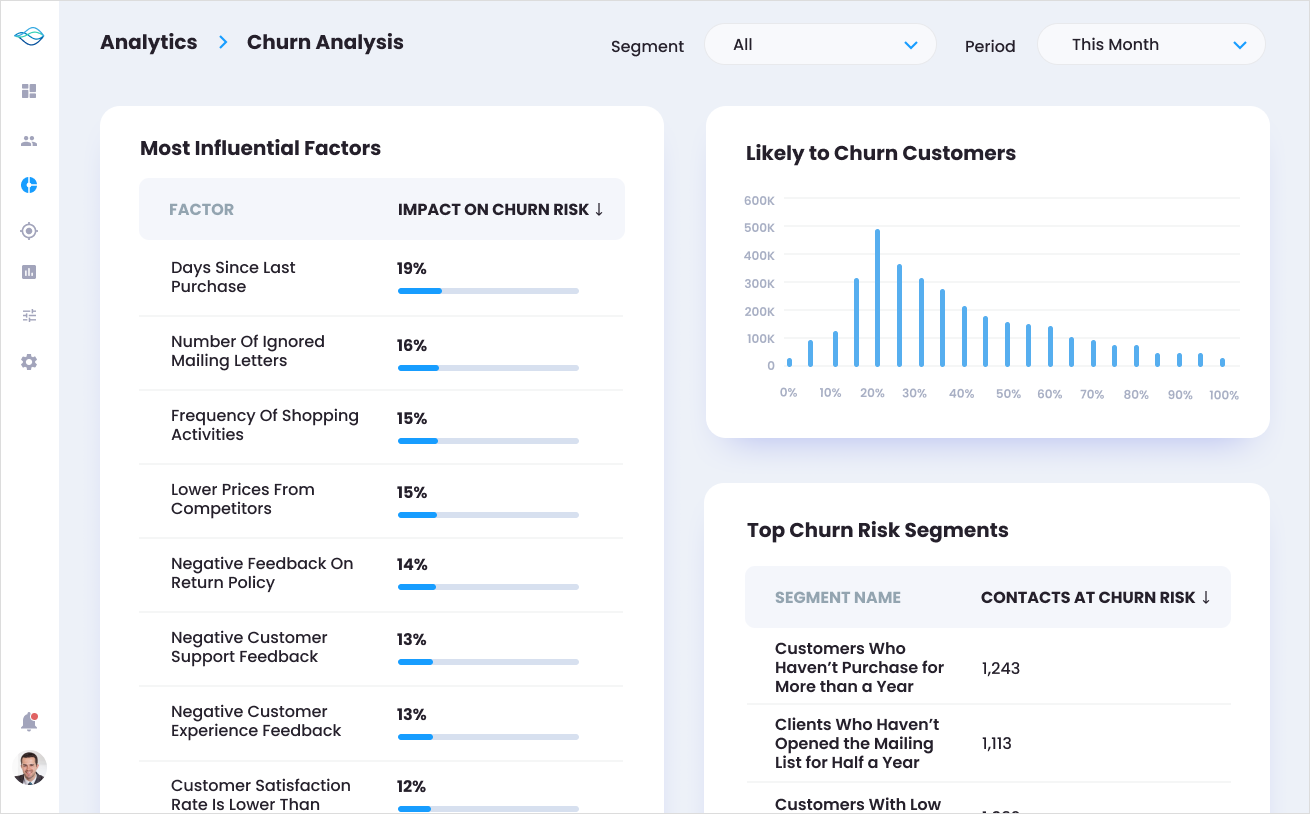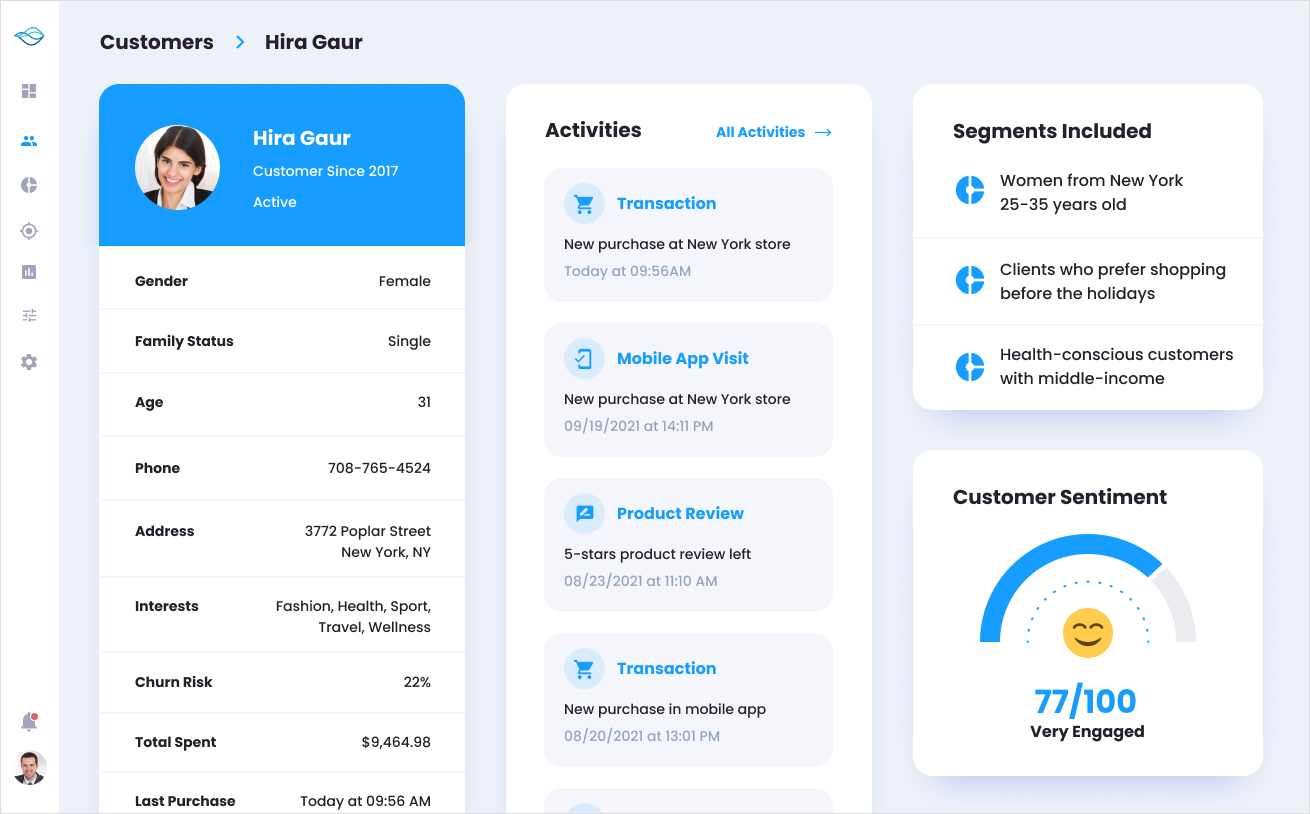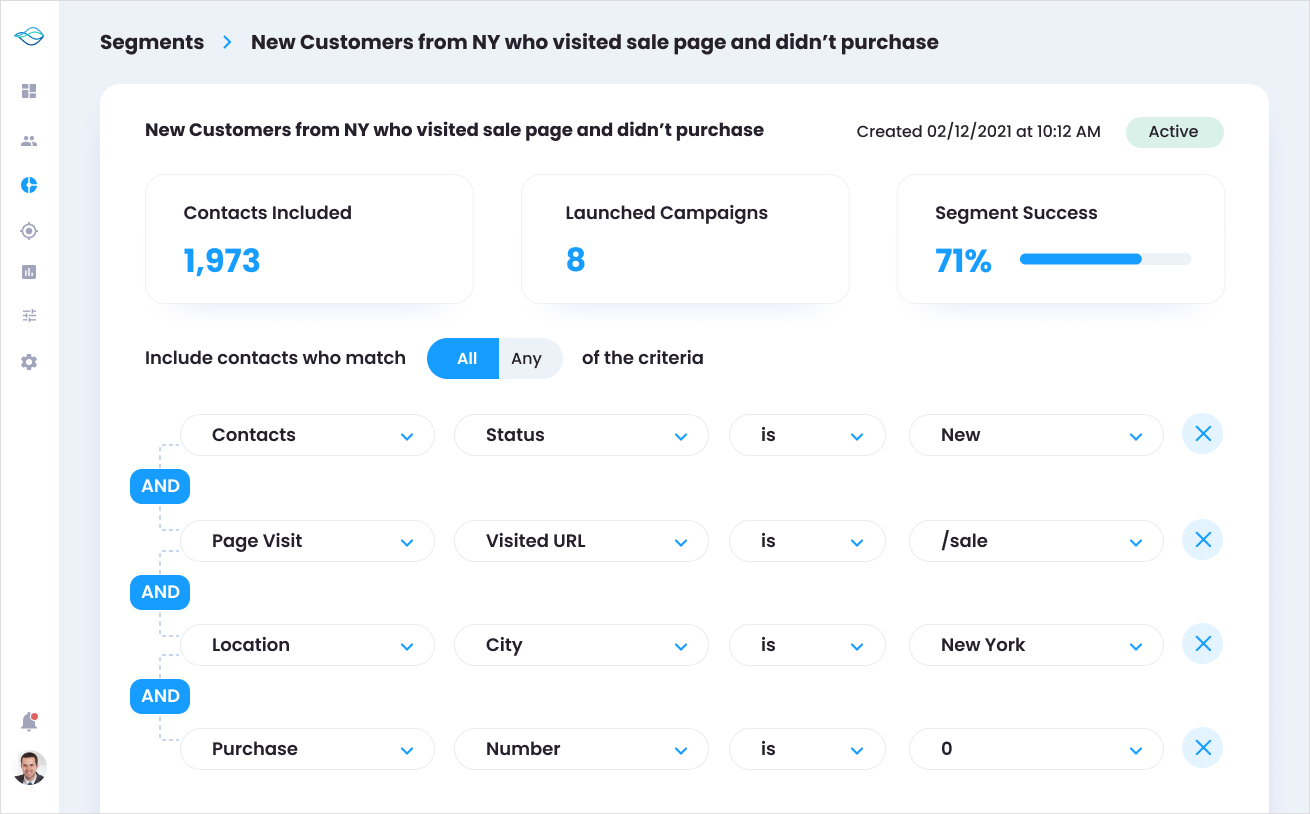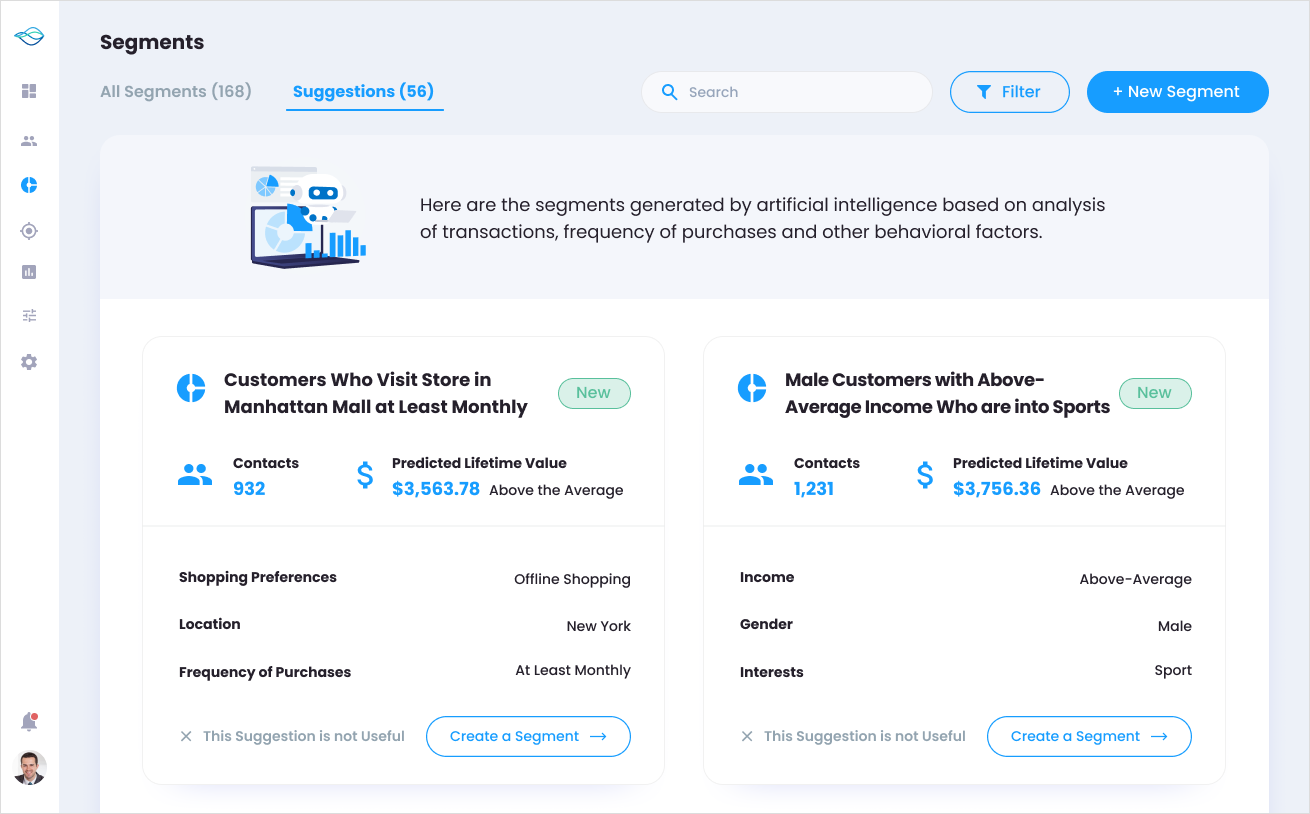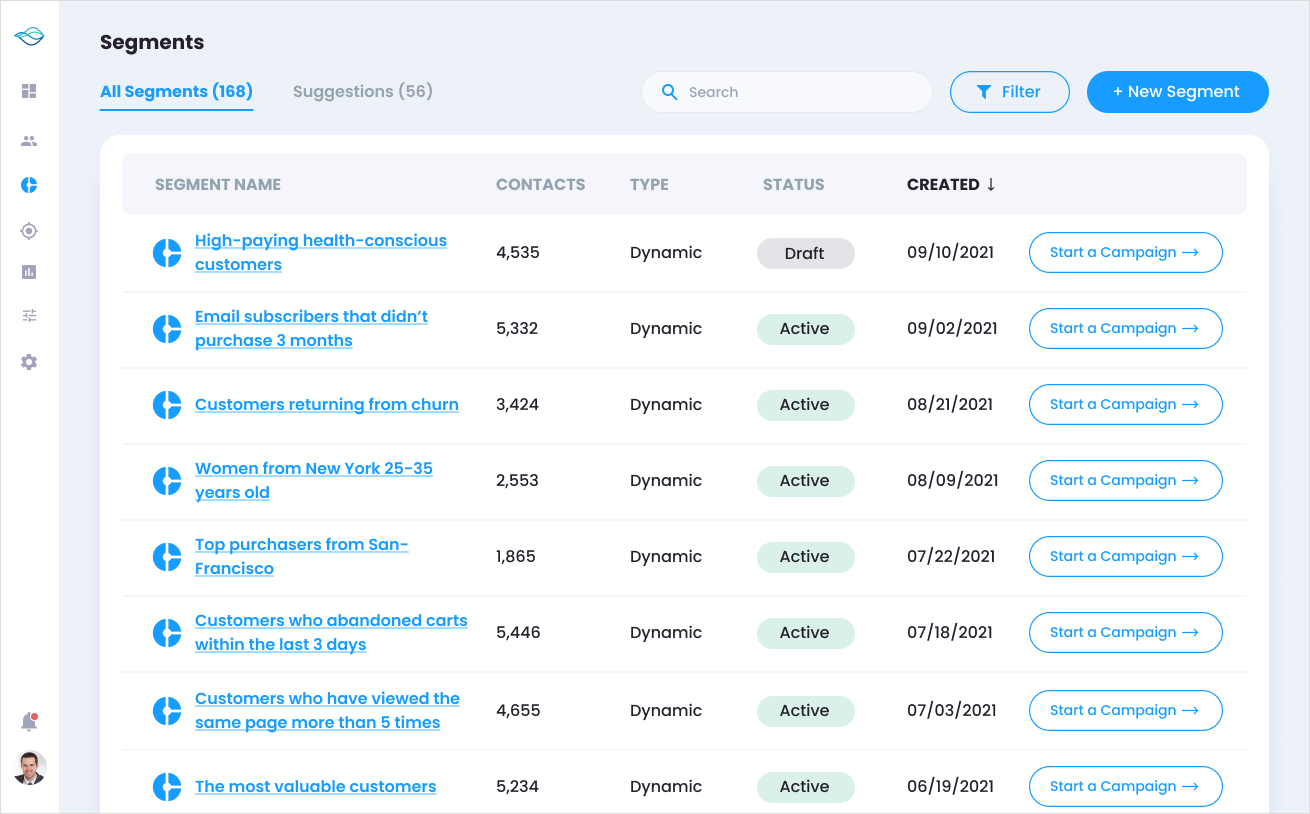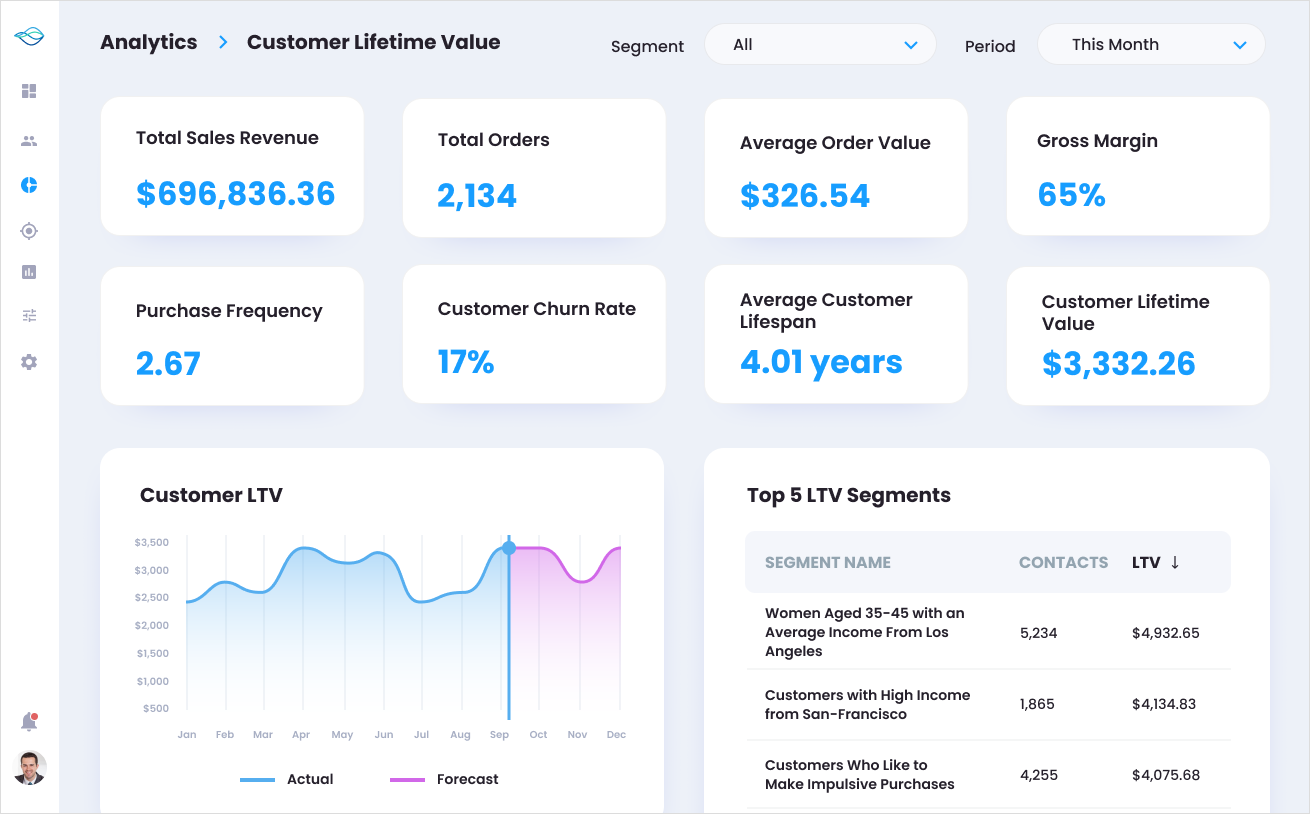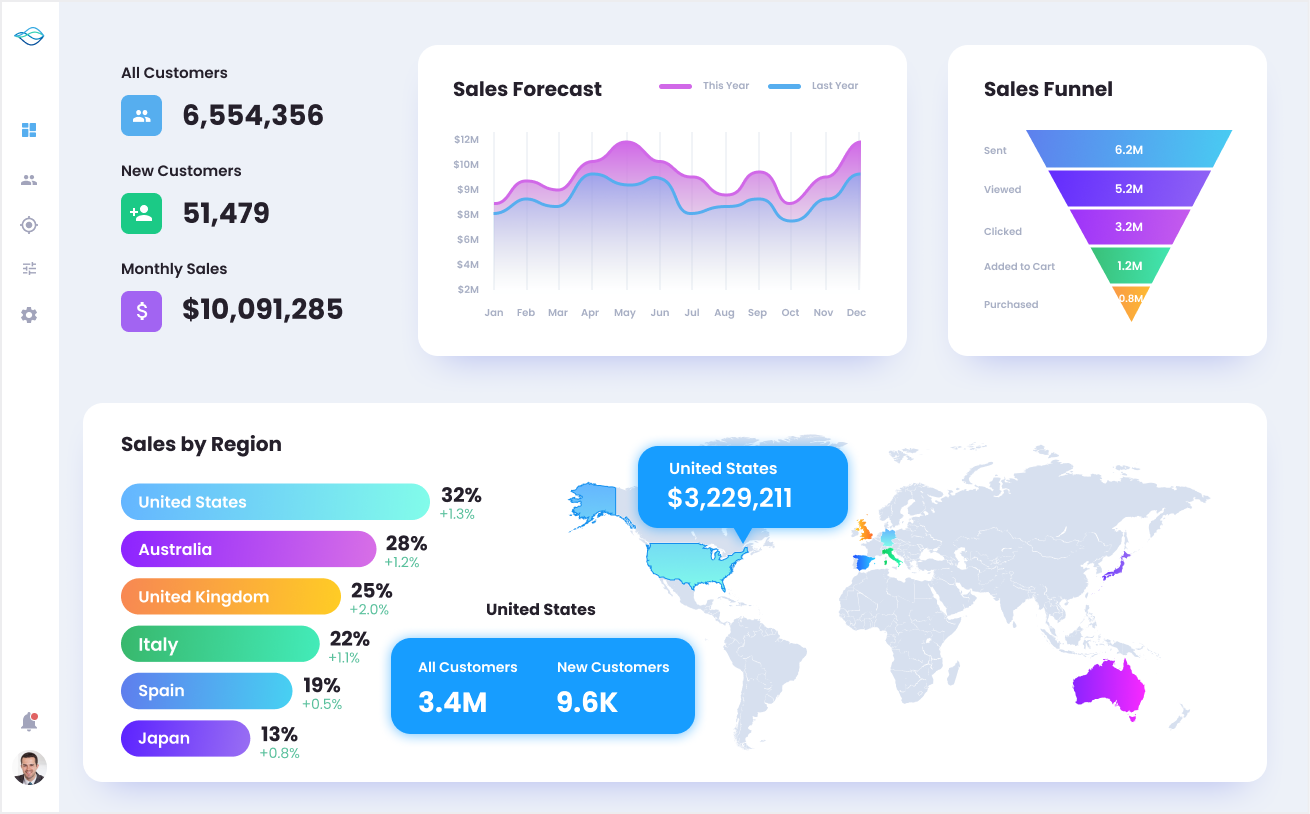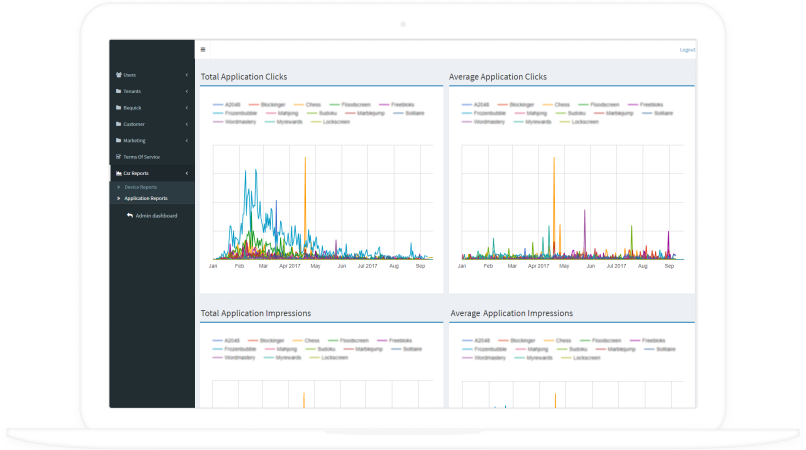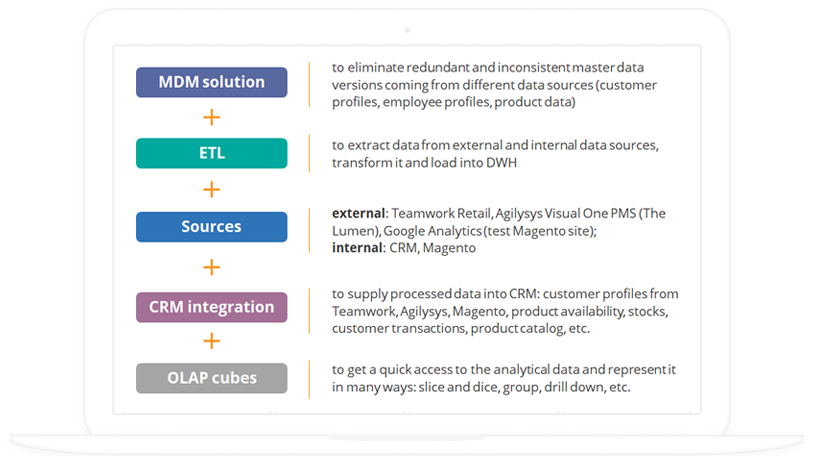Customer Data Analytics
Software Solutions, Costs, and Gains
Having 36 years of experience in data analytics, ScienceSoft advises on, implements and supports custom and platform-based customer analytics software.
Customer Analytics: Summary
Customer analytics is needed to gain insights into customer needs and preferences and develop data-driven marketing and sales strategies. With AI-powered software, it’s also possible to get accurate forecasts of customer behavior and implement real-time personalization for each buyer.
- Key features of customer analytics software to have: customer data collection and management, customer segmentation, customer behavior analytics and prediction, advanced analytics for customer relationship management.
- Important integrations to set up: CRM, an ecommerce platform, a point of sale (POS) system, social media accounts, marketing software.
- Implementation costs: $20,000 – $80,000. Use our online calculator to get a free ballpark quote for your case.
- ROI: 3-year ROI of 730% with a payback period of 12 months.
The Functional Scope of Customer Analytics Solutions
ScienceSoft’s data analytics experts specializing in customer analysis have compiled a set of features for an efficient customer analytics solution:
4 Types of Customer Data to Drive Insights From
Transactional data
Analysis of such data as product/service purchases, returns, reservations, and more gives insights into customers’ spending habits, payment method preference, the share of wallet, etc.
Data about service/product use
Understanding product/service utilization patterns (by analyzing log data, IoT data, requests from customer support service, etc.) helps businesses create a better customer experience and enhance a product/service portfolio.
Web behavior data
Analysis of pages opened by customers, how they scroll down the page, places where they click on purchase/return, etc. It helps identify key points in a customer journey (where customers get stuck/leave/convert), assess the performance of specific pages, and tailor them accordingly.
Customer-generated data
Analysis of customers’ online reviews or social media posts about a product/service helps identify customer preferences, reveal customer complaints and problems to solve and recognize customer attitude to products/services in particular and company brand in general.
See the difference between customer analytics and customer analysis
Customer analytics is often used interchangeably with customer analysis, but the former is a broader term. While customer analytics is about collecting data and applying analytics techniques to it, customer analysis is the process of examining the insights and deciding on the best strategy to act upon them.
Hide
4 Types of Analytics for Customer Data
Depending on your goals, a customer analytics solution may cover one or several analytics types.
Descriptive customer analytics
Discovering what has happened or what is currently happening in business by analyzing historical and real-time customer-related data.
Example: Revealing a drop in sales last month, an increase in the customer attrition rate.
Diagnostic customer analytics
Finding roots of a business problem by analyzing internal and external customer-related data with such techniques as data discovery, data mining, etc.
Example: Drilling down on sales and gross profit to define the reason for missing the net profit target.
Predictive customer analytics
Making predictions and forecasts using data mining and machine learning techniques on historical and real-time customer data.
Example: Estimation of how much revenue can be gained if customers are offered a discount for their next purchase upon certain conditions.
Prescriptive customer analytics
Suggesting the best possible course of action based on the predictive analytics’ estimation of possible future events.
Example: An analytics system recommends offering a 5% coupon to a particular customer segment to get the maximum revenue increase from it.
We always start with designing a data analytics strategy that outlines the right mix of analytics types suitable for particular business needs and allows for incremental implementation of relevant capabilities, from the simplest to more advanced ones.
Consider Professional Customer Analytics Implementation Services
With 36 years of expertise in data analytics and established project management practices, ScienceSoft drives projects to their goals regardless of time and budget constraints, as well as changing requirements.
Customer Analytics Solution: Valuable Integrations
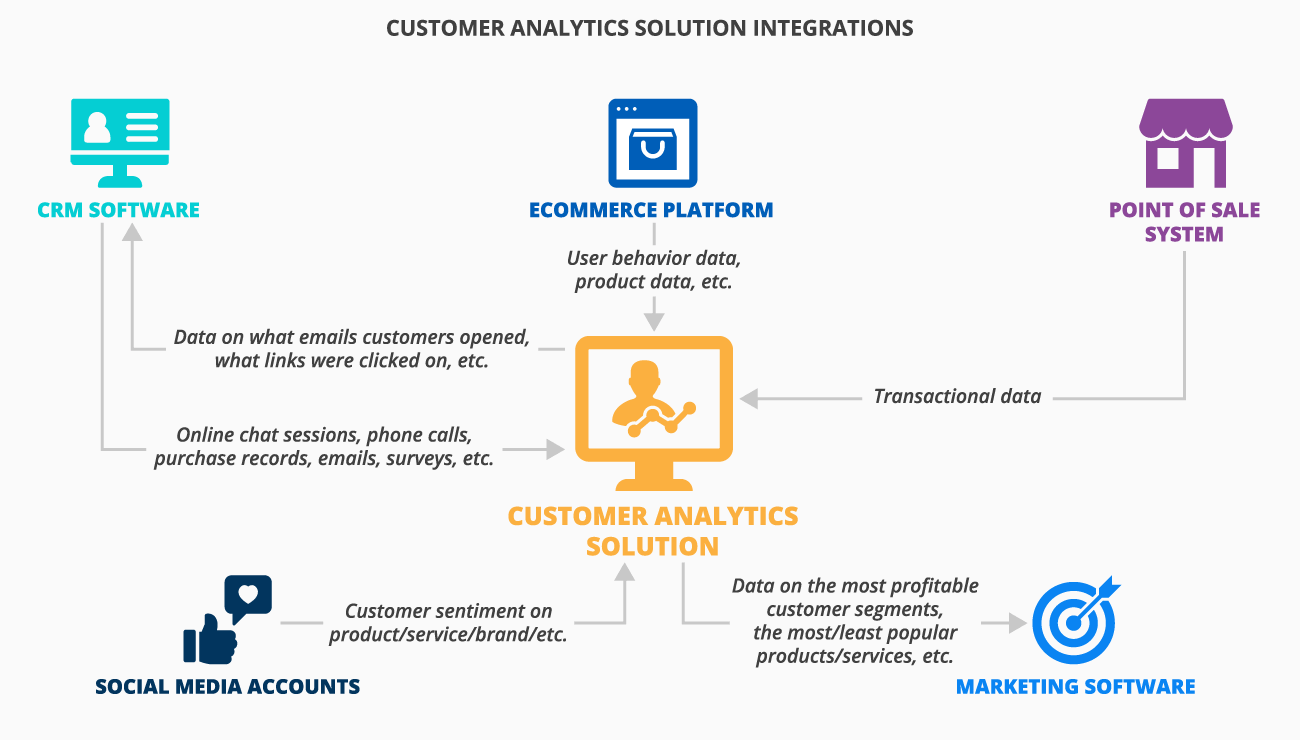
CRM software
Core integration
Automated transfer of CRM data (online chat sessions, phone calls, purchase records, emails, surveys, etc.) to a customer analytics solution to build customer knowledge and discover new sales opportunities. Automated transfer of analytics insights to CRM to be used by marketing, sales, and other customer-facing teams. For example, email analytics results (analysis of what emails customers opened, what links were clicked on, etc.) help define the level of customer engagement and focus the sales efforts accordingly.
Ecommerce platform
Core integration
Automatic loading of ecommerce data (user behavior data, product data, etc.) to a customer analytics solution helps companies track metrics like ecommerce site traffic, conversion rate by devices (PC/tablet/mobile), average order value, revenue by customer group, advertising channel performance, return on ad spend, etc. This data helps determine issues breaking the conversion funnel, track the performance of marketing campaigns, and more.
Point of sale system
Core integration
Point of sale systems feed customer analysis software with transactional data. When analyzed, this data provides insights into customers’ preferences about products/services, payment methods, and purchase time and helps recognize popular product/service bundles.
Social media accounts
Social media accounts supply customer analytics software with customer sentiment on product/service/brand/etc. Analysis of such data allows companies to assess the success of marketing/sales campaigns, measure brand awareness, identify unmet customer needs ahead of competitors, spot emerging consumer trends, and much more.
Marketing software
With automated loading of insights from customer analytics software (data on the most profitable customer segments, the most/least popular products/services and product bundles, key churn drivers, etc.) to marketing software, marketing teams can create personalized marketing campaigns for attracting and converting profitable customers at scale.
Factors Determining the Success of Your Customer Analytics
Below you may find the proven success factors, which ScienceSoft’s experts stick to when working on customer analytics projects:
Well-established data governance
Comprehensive security (data anonymization, end-to-end data encryption, fine-grained access control, data masking, etc.) and data quality management framework (customer data profiling, cleansing and enrichment, master data management, etc.) ensure the safety of customer data under analysis, compliance with relevant regulations (GDPR, HIPAA, etc.), and the quality of analytics insights.
Powerful reporting and visualization capabilities
To easily track the most relevant KPIs (conversion rate, CLTV, CSAT, churn rate, loyalty rate, net promoter score, etc.), visualize customer interactions across various touchpoints, collaborate, and share key analytics findings with colleagues.
Advanced analytics capabilities
To get more accurate insights into customer behavior, discover root causes of customer churn, design highly personalized customer retention campaigns, enable automatic generation of next best offers for customers and action points for sales and marketing specialists, etc.
Customer analytics benefits
Tools to Build a Customer Analytics Solution: ScienceSoft’s Choice
Microsoft Power BI
Features
- Integrating and analyzing customer data from 120+ pre-built data sources for a 360-degree customer view, customer segmentation and profiling.
- Integrating with Azure Data Lake Storage Gen 2 to enable collaboration on customer data across Power BI and Azure data services.
- AI-based customer data preparation and analytics with the Power BI data flows and Power BI Quick Insights features.
- Machine learning modeling to anticipate customer demand, predict customer churn and customer response to marketing campaigns, identify next best product recommendation, etc.
- Customer data discovery with pre-built and custom visuals.
- Role-based collaborating on reports, dashboards and datasets with Power BI workspaces.
- Securing customer data with data sensitivity labeling, end-to-end data encryption, and real-time data access monitoring.
- Available as a SaaS option running in the Azure cloud or as an on-premises option in Power BI Report Server, mobile capabilities.
Watch our Power BI demo.
Best for
Flexible analytics of all customer interaction channels and customer lifecycle stages in B2C and B2B sales.
Pricing
- Power BI Desktop – free,
- Power BI Pro - $9.99/user/month,
- Power BI Premium - $20/user/month, $4,995/dedicated storage and compute resources/month
Salesforce Interaction Studio
Features
- Tracking visitors with unique tracking IDs at every touchpoint on the website/mobile app in real time.
- Identifying individuals across digital channels, matching anonymous and known users to named profiles, tailoring customer identity-matching policies.
- Storing customer data across various sources and consolidating customer profiles across various customer touchpoints (online and offline stores, interactions with call center agents, in-store/in-branch associates, at ATMs, etc.).
- Automated cataloging of all products and content for ML-powered product recommendations for customers.
- Real-time customer segmentation and AI-driven next best offer/action.
- Monitoring of customer digital behavior under various marketing activities/offerings.
- Triggering personalized messages and recommendations on the most relevant products, content, categories, etc. based on customer behavior.
Best for
Digital experience analysis and optimization.
Pricing
Prices are available by direct request to Salesforce.
Looker
Features
- Unifying customer data from customer touchpoints and across various channels for analysis and segmentation.
- Tracking customer KPIs (revenue, shopping cart abandonment, conversion rates, etc.).
- Identifying consumer trends and updating prices based on predictive modeling of supply and demand.
- Tracking the behavior of best customers vs. one-time buyers to design new promotions and marketing tactics.
- Automatic identification of top performers in product categories.
- Configurable alerting capabilities (e.g., setting up rules for receiving email alerts when product restocking is needed).
Best for
Ecommerce analytics
Pricing
Prices are available by direct request to Looker.
When to Opt for Custom Customer Analytics Software
|
|
ScienceSoft recommends custom customer analytics software development in the following cases:
|
Cost Factors and ROI of a Customer Data Analytics Solution
Customer analytics implementation may cost from $20,000 to $80,000, with the investment usually breaking even within 12 months and generating up to 730% ROI in 3 years.
|
|
Factors determining the implementation cost of a customer analytics solution:
|
|
|
Major financial outcomes of implementing customer analytics:
|
About ScienceSoft
ScienceSoft is an IT consulting and software development company headquartered in McKinney, TX. We provide business intelligence consulting services to help our clients turn customer data into insights beneficial for sales, marketing, product development, and customer service. Being ISO 9001 and ISO 27001 certified, we rely on a mature quality management system and guarantee cooperation with us does not pose any risks to our clients’ data security.


